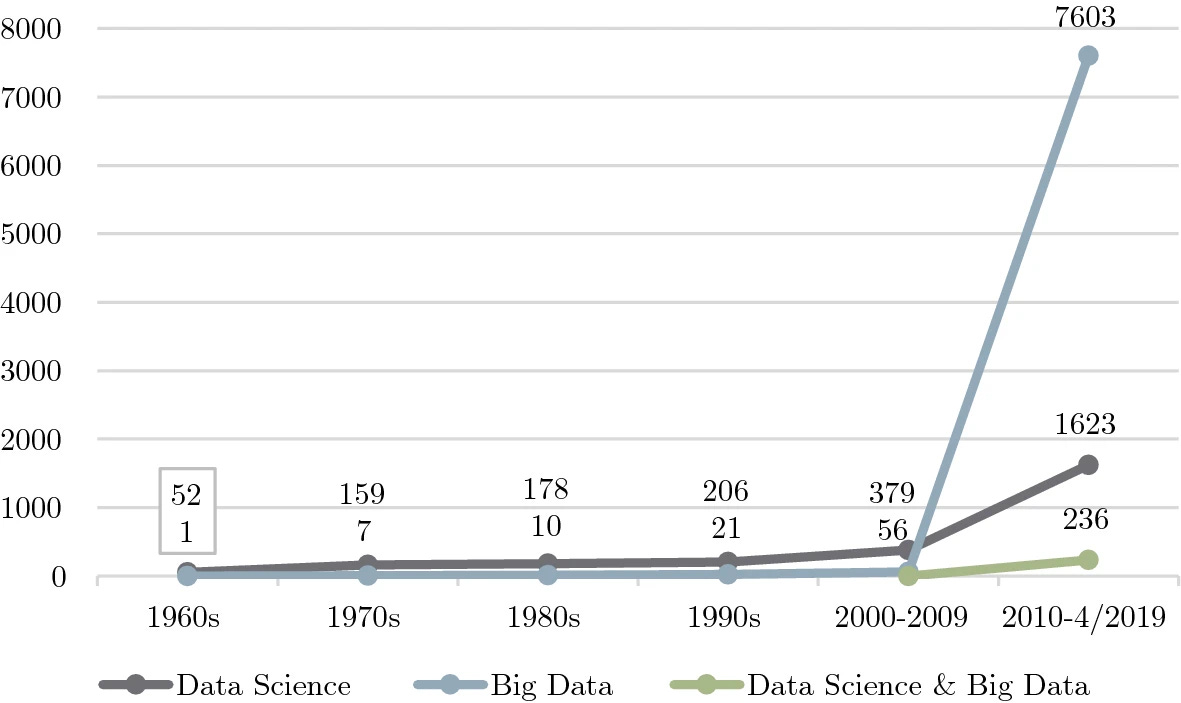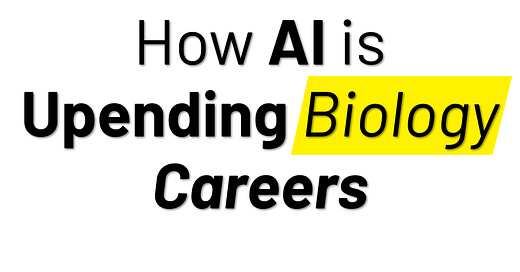How AI is Upending Biology Careers
After years of mindless speculation on if AI would impact your work (the result of denial, no doubt) we’ve finally shifted into a more realistic conversation around how AI will impact your work. How quickly do you need to adopt the new tools to avoid career obsolescence? The Washington Post even published a tool to help you assess the impact based on job title.
The time is now - AI is already changing the nature of work for professionals. For biologists, the tools that will transform the nature of work are already commercially available. What this means for biology careers is that:
Laboratory Technicians will become Verification Technicians
Senior scientist roles will disappear
Principal investigator roles will go to the innovators
Know the present to predict the future (1)
Some of the applications of AI in biology are quite attention-grabbing. DeepMind’s AlphaFold has garnered splashy headlines for its impressive performance in predicting the three-dimensional structures of proteins based on the amino acid sequence. Kintsugi’s model is designed to assess depression based on voice biomarkers (they are currently working with the FDA for De Novo approval). With the appropriate prompt, ChatGPT can write the script to automate your experiment on an Opentrons robot. We take for granted that AI is guiding the identification of drug targets based on large datasets of genetic information - Morgan Stanley predicts this will be a 50 billion dollar market in the next decade.

Some other applications feel more mundane, though that’s not an assessment of value or complexity. These are the tedious and time-consuming tasks that have filled years of bench scientists’ lives: analyzing images with ImageJ (I’m crazy jealous of the new AI tools for ImageJ), prepping samples for PCR, data normalization, and data visualization.
These applications are largely in the category of tools that expedite a process but don’t necessarily involve the synthesis of information. Don’t let this lull you into a false sense of security - these are the tools that will eliminate entry-level lab jobs.
How? Let’s take a brief detour and consider the impact word-processing software has had on the legal profession.
Word processors and the legal industry
It’s no secret that the legal profession, regardless of what field of law, produces large volumes of documents. Contracts, letters, pleadings, contracts, legal memorandums, wills… let's spare ourselves an exhaustive list. In some cases, there is also the need to process huge volumes of documents. The discovery phase of a lawsuit can, in some cases, involve millions of pages of documents.
The impact of word processors and digital documents can be appreciated with the following anecdote (2): in 1978 the Justice Department filed an antitrust lawsuit against CBS that required the review of six million documents. The cost? Over $2.2 million dollars (1978 dollars, no adjustments), largely attributed to salary costs for the many months it took the large team of lawyers and paralegals. By contrast, in 2011 the cost to review over 1.5 million documents was less than $100,000 (2011 dollars, no adjustments). To really appreciate the cost difference I plugged these numbers into a basic inflation calculator and normalized by cost per document: the cost per document dropped more than 94% between 1978 and 2011 (3).
Of course, this also means that job demand for document review has decreased. As with other technology developments, we have found other work for those people to do - after all the total number of people working in legal professions increased across that same time span. But, the new jobs tend to be lower paying, while high-paying jobs become less common.
Let’s bring this back to the realm of biology.
Biology has entered its word processor era
A safe starting assumption is that existing tedium-reducing tools in biology will become increasingly widespread. With the increased adoption of AI and automation:
fewer senior scientists are needed to plan experiments to be performed
fewer lab techs are needed to run experiments
fewer statisticians are needed to process data
The truth of this has already become evident in the explosion of publications using so-called big data. This is only possible because of the ability to generate significantly more data with a similar number of biologists performing the hands-on work. This trend will only accelerate as tools become increasingly interoperable.

Planning for biology careers post-AI
Laboratory Technicians will become Verification Technicians
A lot of biology jobs today are focused on performing routine experiments and processing data. These jobs will be among the first to transform. Why? Because AI makes mistakes. Mistakes that are difficult to predict. We will need dedicated biologists that verify the data being generated. Over time, the nature of verification will change, but we are a long way away from allowing these systems to self-operate without oversight.
If you’re a lab tech performing routine experiments today, anticipate that role transition to experimental verification. This will include ensuring that automations (hardware and software) are set up and documented properly, that critical steps were performed in the right sequence, and that the results ‘make sense’. What does it mean for results to make sense? Here’s a simple analogy - at a glance, you may not know the result of multiplying 11 and 13, but a sniff test tells you that 56 is too small. That’s a result that doesn’t make sense. Biologically, maybe my agonist produced a positive effect and my antagonist produced a negative effect as expected, but the difference between the two was unrealistically small. You would know that result doesn’t make sense, and that something else went wrong.
Senior scientist roles will disappear
Designing a sound experiment requires a clear understanding of the effect you want to measure, the parameters that need to be controlled, and awareness of available techniques. Today that work is often performed by people with advanced degrees in biology or long career experience (often both). As of writing this, I can already ask OpenAI’s ChatGPT or Google’s Bard to design a protocol. The protocols I got back in response to my query were solid. When I did a sloppy job of describing the experiment I got results that were okay - I would say 90% usable with errors that were glaringly obvious and easy to fix. When I tightened up the query with a little more specificity (still just a two-sentence prompt) I got results that were 100% usable.
This means that principal investigators will need fewer senior scientists for their labs. They will need senior biologists who are able to think creatively and form hypotheses capable of uncovering unique insights. To be competitive, you will need to be proficient with cutting-edge AI tools (4). It’s a tricky path, but perfect for those who love to constantly learn how to use new tools and are driven by a desire to maximize efficiency at every opportunity.
Principal investigator roles will go to the innovators
Today, there are a small number of principal investigators who are forging into uncharted territories of knowledge while a far larger number explore how those discoveries apply to related biology. For example, Brian Kobilka and Robert Lefkowitz uncovered the structure and function of the beta-2-adrenergic receptor (for which they received the Nobel Prize in Chemistry in 2012). Countless other labs have pursued how that knowledge applies to other G protein-coupled receptors, with publications largely focusing on how specific receptors differ from the observations made about the beta-2-adrenergic receptor. Looking forward, AI will be able to largely design and oversee the scientific exploration into how breakthrough discoveries apply.
This model of research has meant that, in recent years, the best way to optimize for a successful career as a Principal Investigator (or industry equivalent) was to go deep on a single topic and get lots of publications. But, this was bad for innovation (5).
There’s new hope - AI and automation will thrive at going deep in specific fields, especially once pioneering work into something similar has already been performed. This will erode the currently popular career path; instead, biologists will bring unique value when they combine unexpected concepts and disciplines.
If your goal is to be a PI or a similar work - your differentiator will be your inimitable thoughts. Your goal should be to diversify your expertise and pursue innovative hypotheses; the ability to grind to hours at repetitive tasks is your least valuable asset.
This is a nod to Carl Sagan’s infamous quote, “You have to know the past to understand the present.”
There are actually a lot of fascinating articles about this concept if you query your favorite search engine. This NYTimes article from 2011 includes the anecdote given here and is a nice starting point.
This envelope calculation was performed as follows: I used this inflation calculator to compare the buying power of the US dollar in 1978 and 2011 (other online calculators yielded similar results). In the 1978 example, it was approximately $0.37 per document, which was the equivalent of $1.28 in 2011 dollars. By contrast, it was approximately $0.07 per document in 2011. Comparing $1.28 to $0.07 resulted in the computed >94% decrease in per document cost.
A quick hop into your search engine of choice can help you find lots of tutorials. If you’re just starting to dip your toes in the water, this video can help you see the opportunities from a high level, this one can help you understand opportunities for qualitative research, and this one walks through how you can use ChatGPT for writing papers.
If you are not already familiar with this study, I beg you to read it. This blog is also a nice analysis of the paper.



